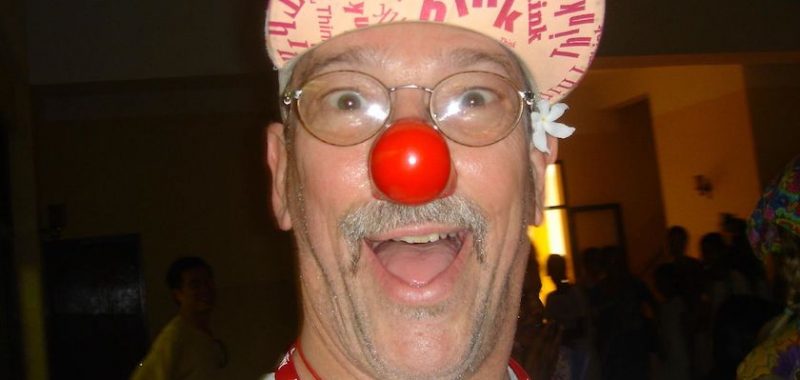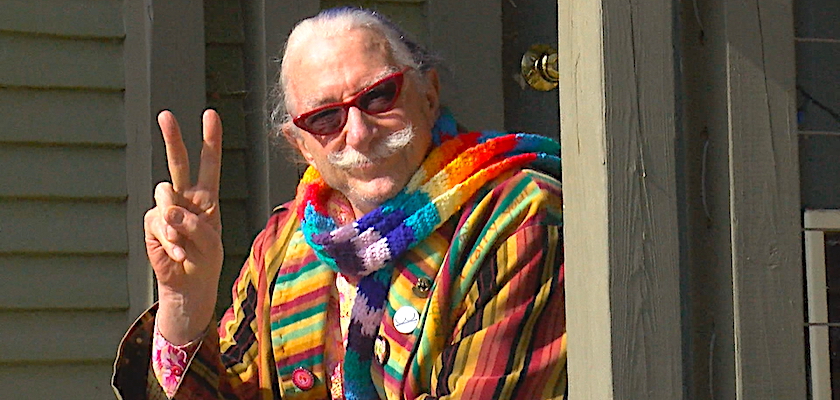Our debt to 'Patch' Adams

What's the first thing you think of when you hear the word 'hospital' – and what pops into your head when a doctor's name is mentioned?
To me, these words conjure up images of cold white clinical buildings, illness, death and generally not somewhere you want to be. However, thankfully in the 21st Century, these worries can usually be put to bed, and we have the NHS to thank for a huge improvement in healthcare.
But in 1960s America, hospital treatment standards were poor. Hospitals were outdated and underfunded and as a result, staff were undertrained and disillusioned. Enter the healthcare system with an illness was something to fear as patients really had no idea what kind of care they were going to receive.
This lasted until an eccentric medical student, in his early 20s, started to look outside the box – and took it upon himself to change the face of hospital care.

THE ENTERTAINER: Hunter 'Patch' Adams likes to make patients smile because it aids their recovery.
Hunter Doherty Adams was born in Washington in 1945, to parents Robert and Anna Adams. Father Robert was an officer in the US Army. While stationed in the former West Germany, Robert suddenly died. At the time, Hunter was only 16-years-old. With no ties to Europe, the family moved back to the US where teenager Adams experienced severe bullying at school. The relentless abuse and torment he received led Adams to develop depression and anxiety, attempt suicide and be hospitalised three times in one year.
During his stays in various hospitals, Adams observed how patients were being treated. He saw how robotic and emotionless medical care had become and as David Stout noted in his New York Times article: "Adams saw medicine itself as critically ill from an emotional void between doctors and patients, the days of an old-fashioned personal house call had vanished, and the near-industrialization of medical treatment had emerged."
It was during his time in hospital that he began to use his nickname after one of the patients dubbed him 'Patch' – after their evolving friendship had patched up the loneliness in his life.
After significant improvements in his mental health and spurred on by the things he had experienced in hospital and the people he had met, Patch decided to pursue a career in medicine. He completed pre-med coursework at the University of Washington and progressed on to study medicine at Virginia medical college. It was during his time at medical school that Patch really saw the terrible state that US hospitals were in and how patients were being treated. He saw seriously ill people receiving very basic levels of compassion, while empathy was replaced by numbers, figures and quotas that needed to be met at any cost. He also noticed a lot of patients were being discriminated against and denied certain treatments due to not having the correct medical insurance, or not being able to afford the right level of care they required.

INTERNATIONAL RECOGNITION: Patch Adams was nominated for the 2021 Nobel Peace Prize.
Patch became determined to tackle this great injustice.
He believed a patients’ health was directly linked to the amount of regular human contact they received. Convinced this was an important dynamic in treating many conditions, he would sit and talk to the ill and infirm for hours, reassuring them, making them laugh and being there for them. This was something hospitals didn’t encourage at the time.
After graduating with a medical degree, Dr Hunter ‘Patch’ Adams set the wheels in motion to create a free medical centre, which promoted the idea of spreading laughter, positivity, and compassion to all who required medical help no matter who they were.
Patch, his future wife, and some medical school friends founded the Gesundheit! Institute in 1971 as a free community hospital run by staff and friends and funded by donations.
Since its founding, this place of peace, compassion and medical excellence has provided care for thousands of patients and regularly runs 'clown travel expeditions' to underdeveloped parts of the world where Patch, his family, friends, and medical professionals provide free healthcare and comic relief dressed as sideshow clowns.

A HARD ACT TO FOLLOW: Robin Williams brought Patch's exploits to the big screen.
In 1998, Tom Shadyac directed a film based on this remarkable man's life. Patch Adams starred Robin Williams in the lead role and all monies paid to Patch were used to provide more resources for the hospital's patients.
Now 76, Adams has taken a step back from the everyday running of Gesundheit! to enjoy his semi-retirement, leaving the management of the hospital and the organising of a proposed 30-bedroom new hospital building to his two sons Zag and Lars Adams. But Patch hosts regular Facebook Q&As and is still to be seen wearing various bright and silly clown outfits almost every day in his quest to entertain people.
If you would like to learn more about Patch’s mission and the Gesundheit! Institute, please click here.
Louis Mason is a freelance journalist who regularly writes features and columns for Sorted.

